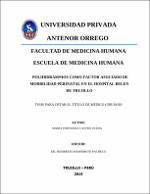Polihidramnios como factor asociado de morbilidad perinatal en el hospital Belén de Trujillo

View/
Download
(application/pdf: 321.8Kb)
(application/pdf: 321.8Kb)
Date
2015Author(s)
Castro Uceda, Maria Fernanda
Metadata
Show full item recordAbstract
Determinar si el polihidramnios constituye un factor asociado de morbilidad perinatal: parto pre término, óbito fetal y ruptura prematura de membranas, en el Hospital Belén De Trujillo.
MATERIAL Y MÉTODO: Realizamos un estudio observacional, analítico, de cohortes, que evaluó 122 gestantes, distribuidas en dos grupos, grupo I (61 pacientes con polihidramnios) y grupo II (61 pacientes sin polihidramnios), que tuvieron su parto en el periodo de tiempo comprendido entre Enero del 2011 a Diciembre del 2014.
RESULTADOS: La edad promedio de las pacientes del grupo I fue 28,77 ± 7,36 años y de las pacientes del grupo II fue 30,56 ± 7,80 años (p > 0,05); la edad gestacional al momento del parto fueron 36,30 ± 3,37 y 38,59 ± 1,67 semanas respectivamente (p < 0,001). Los promedios del Índice de líquido amniótico fueron 27,98 ± 3,69 y 10,18 ± 3,98 respectivamente (p < 0,001). En lo que respecta a la morbilidad perinatal y los grupos de estudio, se observó que la prematuridad estuvo presente en 52,46% y 21,31% en los grupos I y II respectivamente (p < 0,001); el bajo peso del RN en 32,79% y 6,56% (p < 0,001); asfixia neonatal en 21,31% y 1,64% (p < 0,01); RPM en 3,28% y 6,56% (p > 0,05); el óbito fetal en 4,92% y 0% (p > 0,05) y la muerte neonatal precoz en 14,75% y 1,64% respectivamente (p < 0,01).
CONCLUSIONES: El polihidramnios resultó ser un factor asociado a mortalidad perinatal, siendo la prematuridad, el bajo peso del RN, la asfixia neonatal y la muerte neonatal precoz, las complicaciones significativamente asociadas al polihidramnios. Determine if polyhydramnios is a factor associated perinatal
morbidity: preterm delivery, stillbirth and premature rupture of membranes, in
the Bethlehem Hospital De Trujillo.
MATERIAL AND METHODS: We conducted an observational, analytical,
cohort study, which evaluated 122 pregnant women divided into two groups,
group I (61 patients with polyhydramnios) and group II (61 patients without
polyhydramnios), who gave birth in the period between January 2011 to
December 2014.
RESULTS: The mean age of the patients in group I was 28.77 ± 7.36 years and
patients group II was 30.56 ± 7.80 years (p > 0.05); gestational age at delivery
was 36.30 ± 3.37 and 38.59 ± 1.67 weeks respectively (p < 0.001). The means
amniotic fluid index was 27.98 ± 3.69 and 10.18 ± 3.98 respectively (p <
0.001). With respect to perinatal morbidity and study groups, we observed that
prematurity attended 21.31% and 52.46% in Groups I and II respectively (p <
0.001); RN underweight in 32.79% and 6.56% (p < 0.001); neonatal asphyxia
21.31% and 1.64% (p < 0.01); RPM at 3.28% and 6.56% (p > 0.05); stillbirth at
4.92% and 0% (p > 0.05) and early neonatal death in 14.75% and 1.64%
respectively (p < 0.01).
CONCLUSIONS: The polyhydramnios was found to be a factor associated
with perinatal mortality, with prematurity, low birth weight of the newborn,
neonatal asphyxia and early neonatal death, complications significantly
associated with polyhydramnios.
Subject
Collections
- Medicina Humana [2969]

